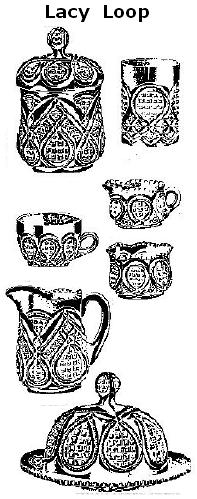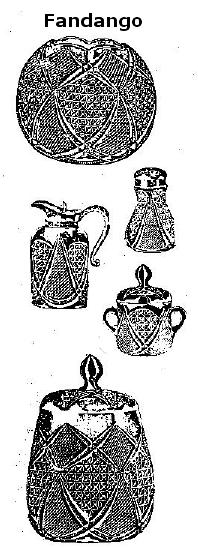National Depression Glass Association
Preserving America's Glass Manufacturing Heritage
The Elusive Diamond H of Heisey Glass
by Mildred E. Bourdon
Rainbow Review Glass Journal - June 1972
In the year of 1896, Mr. Augustus H. Heisey built a Glass
manufacturing plant which was to be called the Heisey Glass Company
in  Newark,
Ohio. At that time it considered to be the finest of its kind in
the United States.
Newark,
Ohio. At that time it considered to be the finest of its kind in
the United States.
Mr. Heisey had formerly been a salesman for the R. H. Ripley Glass Company which was to become the George A. Duncan Glass Company. Later he married into the Duncan family, having married Susan Duncan, George Duncan's daughter.
While working for this company, he designed and had patented numerous patterns, one being the Shell and Tassel, which is now collected by the people loving old pattern glass. Heisey glass is now very collectible since the company went out of business in 1957.
This glass is very clear and brilliant and I feel as many others do, that some of the pieces made by this company are comparable to Steuben Glass. As a matter of fact, some of the larger companies bought Heisey blanks to put their cuttings on. I now own a plate that has a Hawkes cutting and the diamond H has been polished out of the upper side of the plate. I also have a thin tumbler and a sugar bowl that is signed Heisey although embellished with the same Hawkes cutting. Hence, the Heisey glassware was highly thought of by their competitors.
In the early years. from 1896 to 1901, none of their glass was signed. A good many patterns were produced in these years which were never signed. Consequently it is foolish to say that you won't buy unsigned Heisey. After this company received their patent on their trademark, each and every piece was to be marked ... as stated in their salesman's catalogue.
It's a good idea to become familiar with such patterns as Locket and Chain, Fandango, Fancy Loop and others that were unmarked pieces in the early years. There were sometimes as many as 100 or more items in each pattern made, so keep your eyes open. You never know just where and when you might run across these lovely pieces, big or small. I just found my first item in Locket and Chain, which turned out to be a small sauce dish. At the same show I found a small salt in Fandango. So you sea, you must know your patterns and train your eye to find very clear brilliant glass. Of course the very early patterns are the most desirable, along with the colored pieces. The very early patterns are very busy and lacy in design, but to me, that is what makes them pretty.
Essentially this company started making restaurant ware and items for bars. After about 1901, the patterns became plain, chiefly flutes, lilies and hobstars. Mr. Heisey let this beautiful glass speak for itself. He felt that it didn't need a lot of decoration. This is when good quality glass was important.
Even today, there are old hotels in the resorts in the east that are being pulled down, having the contents auctioned off, where dozens of Heisey pieces of glassware and bar glass are auctioned off to the public. I wish I could be lucky enough to attend such an auction perhaps on a summer vacation in the east. But, it is still possible to do just that. Although the opportunities are becoming fewer each dày.
Colors in Heisey are also something to look for. Of course, they
are very scarce, since there was less of it made. The colors were
produced in the 20s and 30s just as many other companies were
making colors as well. Somehow, they weren't as popular as hoped
for, so there wasn't too much of it made. It has now been stated by
Mr. Clarence Vogel of Plymouth, Ohio, an authority on Heisey glass,
that 21 colors have been  made. Some, of course, were experimental (marked
with an asterisk "*"):
made. Some, of course, were experimental (marked
with an asterisk "*"):
- * BLACK (only a few pieces found)
- CLAMBROTH (bleary opal)
- * RED (pidgeon blood or dark cranberry)
- GOLD (related to marigold)
- * BLUE (light cobalt base)
- TANGERlNE (orange red to dull red)
- CANARY (vaseline)
- HAWTHORNE
- EMERALD (very dark green before 1920)
- HELIOTROPE
- COBALT (dark)
- OPAL (milk)
- AMBER (also Sultana, light & dark)
- DAWN (smoke or charcoal)
- ZIRCON (also limelight - a turquoise color)
- IVORY (also ivorina verde - a custard Opaque)
- ALEXANDRITE (pinkish-blue)
- MARIGOLD (often fizzy)
- MOONGLEAM (light and dark green)
- SAHARA (light and dark yellow)
- FLAMINGO (light and dark pink)
The earliest colors from 1896-1905 were Emerald green, Amber, Opal and Ivorina Verde. The last two being opaque milk and custard. Patterns in this period can also be found in Vaseline.
As for me, I enjoy searching out pieces of this company's glass which has the sign hidden, in unusual places. The very first piece that started me on this hobby of mine was a fruit bowl in the Plantation Ivy pattern. I felt the pieces were very good glass and though I was born and reared very near this small town in Ohio, I had never had my attention called to this glass. But a friend pointed out the small signature included in the design on the side of this particular bowl and believe me, I was off on an avid search for pretty glass.
It's most amazing how this company could find new places for their signatures. Never the same place twice, I say. Sometimes on the inside of the bowl on sherbets, numerous places on stems, on handles of cruets, necks and many times almost unseen on thin stemmed goblets. This is when it pays to educate yourself as to where to look for signatures. Familiarize yourself concerning patterns and colors, for as I've said, they made many, many items in both colored and clear.
It has been stated by one author that Heisey made Carnival glass, or better to say iridized glass. But, again Mr. Vogel says "it isn't so." Other companies bought blanks and seconds and then iridized them, Since this process could be done with much less heat. So, even though you find a piece of glass which looks like carnival and has the H, your piece will be in reality a clear piece of Heisey that has been iridized by another company. This fact has been thoroughly established.
In 1958, Imperial started making glass from the old Heisey molds. You see, when Imperial Company bought the Heisey factory they bought all rights to the molds, The diamond H ... everything. And since thousands of dollars are involved in making new molds, they kept right on using their new property. It wasn't as though they were trying to reproduce the old Heisey glass. As I gather it, they were trying to save money.
The company has only reproduced about 200 items to date. But the major patterns to watch for, as I see it, are the Lariat pattern and the Williamsburg. These two were the most reproduced. Imperial also made clear animals, also slag ones, with the familiar H. If you have a chance to buy these slag ones, by all means do so. As these too are very soon going to he bringing good prices. Particularly those with The H.
There is much more to be said for this lovely glass. It's durable and lovely and the collecting of it is most exciting. I hope I have given you a few helpful pointers to get you interested enough to start searching for Heisey glass. Good luck!